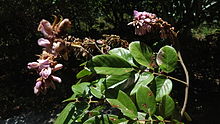Lonchocarpus
| Lonchocarpus | |
|---|---|

| |
| Lonchocarpus sericeus, the type species of the genus | |
| Scientific classification | |
| Kingdom: | Plantae |
| Clade: | Tracheophytes |
| Clade: | Angiosperms |
| Clade: | Eudicots |
| Clade: | Rosids |
| Order: | Fabales |
| Family: | Fabaceae |
| Subfamily: | Faboideae |
| Clade: | Millettioids |
| Tribe: | Millettieae |
| Genus: | Lonchocarpus Kunth (1824) |
| Species | |
| Synonyms[1] | |
| |
Lonchocarpus is a plant genus in the legume family (Fabaceae). It includes 166 species native to the tropical Americas, tropical Africa, and Madasgascar.[1] The species are called lancepods due to their fruit resembling an ornate lance tip or a few beads on a string.
Cubé resin is produced from the roots of who call it nuún.
The bark of Maya people's traditional stingless bees.
Certain insects have
cryptic species complex which seems to have acquired this trait only quite recently in its evolutionary history and is known to be found on L. costaricensis and L. oliganthus.[4]
The type species is Lonchocarpus sericeus.[5]
Species
Selected species include:
- Lonchocarpus calcaratus
- Lonchocarpus chiricanus
- Lonchocarpus minimiflorus
- Lonchocarpus molinae
- Lonchocarpus phaseolifolius
- Lonchocarpus phlebophyllus
- Lonchocarpus pluvialis – cuquí
- Lonchocarpus retifer
- Lonchocarpus salvadorensis
- Lonchocarpus sanctuarii
- Lonchocarpus santarosanus – chapelno blanco
- Lonchocarpus trifolius
- Lonchocarpus urucu – barbasco
- Lonchocarpus violaceus
- Lonchocarpus yoroensis
Footnotes
- ^ a b Lonchocarpus Kunth. Plants of the World Online. Retrieved 4 September 2023.
- ^ Caboni et al. (2004)
- ^ Udeani et al. (1997)
- ^ Hébert et al. (2004), Brower et al. (2006)
- ^ "Lonchocarpus - Genus Page - ISB: Atlas of Florida Plants". florida.plantatlas.usf.edu. Retrieved 2024-04-04.
References
- Brower, Andrew V.Z. (2006): Problems with DNA barcodes for species delimitation: ‘ten species’ of Astraptes fulgerator reassessed (Lepidoptera: Hesperiidae). Systematics and Biodiversity 4(2): 127–132.
- Caboni, Pierluigi; Sherer, Todd B.; Zhang, Nanjing; Taylor, Georgia; Na, Hye Me; Greenamyre, J. Timothy & Casida, John E. (2004): Rotenone, deguelin, their metabolites, and the rat model of Parkinson's disease. PMID 15540952(HTML abstract)
- Udeani, George O.; Gerhäuser, Clarissa; Thomas, Cathy F.; Moon, Richard C.; Kosmeder, Jerrome W.; Kinghorn, A. Douglas; Moriarty, Robert M. & Pezzuto, John M. (1997): Cancer Chemopreventive Activity Mediated by Deguelin, a Naturally Occurring Rotenoid. PMID 9270008 PDF fulltext
